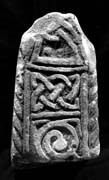Select a site alphabetically from the choices shown in the box below. Alternatively, browse sculptural examples using the Forward/Back buttons.
Chapters for this volume, along with copies of original in-text images, are available here.
Object type: Upper part of cross-shaft and lower part of -head
Measurements: H. 44.5 cm (17.5 in); W. 25 > 23 cm (9.8 > 9 in); D. 16.3 > 14.5 cm (6.4 > 5.7 in)
Stone type: All the pieces from this site were cut from the same stone type and show similar geological attributions. A medium-grained, relatively well-sorted sandstone with sub-angular to sub-rounded grains. Fresh alkali feldspar is present in this rock, together with subordinate amounts of muscovite mica flakes. Occasional flattened limonitic concretions are also present up to 20mm in length. Colour predominantly light yellowish brown (10YR 6/4). There are signs of slight reddening in places — light reddish brown (5YR 6/4) to reddish yellow (5YR 6/4). This reddening is probably natural (i.e. not burnt), caused by water percolating below the Permian unconformity. The stone probably originated very locally. The Coal Measures Sandstone (the Wickersley Rock), which fits the above description, is found approximately 3 km to the west of Frickley, where it was quarried sporadically as a favoured building stone up to the nineteenth century. [J.S.]
Plate numbers in printed volume: Ills. 260-3
Corpus volume reference: Vol 8 p. 152-3
(There may be more views or larger images available for this item. Click on the thumbnail image to view.)
An incomplete shaft of rectangular section, with part of the lower arm of the cross-head. All the angles have a heavy cable-moulding. The background is quite roughly dressed. The strands are cut with straight sides. But some have a humped upper surface, some are flatter. This may be the result of differential wear. The form of the head is not clear.
A (broad): Inner roll mouldings edge the shaft within the cable-moulded angles, and separate the lower part of the cross-head and the two surviving panels. (i) The cross-head has a interlace or twist with a thinner, flatter strand than in panel ii below, and with a bar terminal, from which the strands pass through a loop or possibly a loose ring. There are two loose pellets framed by the terminal. (ii) The upper panel has one register of simple pattern B disposed horizontally: the interlace strand is humped. (iii) The lower panel has one volute of a scroll with a round berry bunch and two stylised leaves bent to fit into the two upper corners of the panel. The strand is flatter, as in the head.
B (narrow): At the top there seems to be the broken remains of the outward curve for the side arm. There is an inner roll moulding at the sides and top of the carved face. Within this is a simple twist, with its humped strands terminating abruptly against the upper edge.
C (broad): The damaged lower arm of the head has traces of one interlace loop on the left, and the outer curve of another on the right. The remaining shaft is not sub-divided into panels like face A, but has a continuous interlace pattern, one register of half-pattern C and the top of another register, either the same or half pattern D.
D (narrow): The same as face B, but the strand is flatter than on B.
The cabled angles, plant-scroll, panelled face, and fine-stranded interlace all look back to Anglian sculpture of the eighth to ninth century (of which there are many examples in the West Riding), but the large scale and very open interlace, the use of a continuous simple twist to fill a whole side, and the use of half-patterns, are all simplifications of the earlier programme, and suggest it is late in the series. There is no obvious trace of Scandinavian influence. Compare, for example, a grave-cover from Hurworth (no. 2), co. Durham (Cramp 1984, 105–6, fig. 11, pl. 89.471–3); and crosses in Cumbria such as Urswick 1 (Bailey and Cramp 1988, 148–50, ills. 565–6, 568–9) and Waberthwaite 1 (ibid., 151, ills. 571–2, 577–8). There are many examples of the two-strand twist, but in early sculptures (seventh to early ninth century) it usually occurs as a narrow border or edging element: however, on Dewsbury 10B and D, although on a very small-scale head, a fine-cut step pattern also looks like an angular version of a simple twist used as a side ornament (Ills. 232, 234). Its large-scale use seems confined to late Anglian sculptures, in the period either just before or overlapping with the era of Viking influence. This use of the large-scale twist occurs in the West Riding on a fragment from Stansfield (Ill. 720), where it is combined with a large-scale interlace (compare Frickley 3 below) and an animal interlace which could be a less garbled version of Frickley 2 below, face A, if that is animal interlace. At Stansfield, however, other elements suggest that this type of decoration continued into the Anglo-Scandinavian period.



